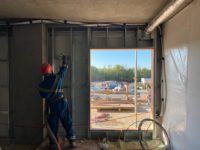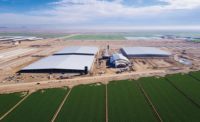Global Prefabricated Insulation Market Report
Global prefabricated building insulation market is projected to grow at a CAGR of 6.2 percent through 2032.

Photo courtesy of Knauf
The "Global Prefabricated Building Insulation Market by Insulation Material (Mineral Wool, Foamed Plastics, Cellulose, Vacuum Insulated Panels, Others), by Insulation Type (Thermal Insulation, Acoustic Insulation, Fire-Resistant Insulation), by Construction System (Panel Systems, Modular Systems, Hybrid Systems), by Application (Walls & Panels, Roof Insulation, Floor & Foundation Insulation, Ceiling & Attic Insulation), by Building Type (Residential, Commercial, Industrial & Institutional) and by Regions - Forecast to 2032" report has been added to Tersus Strategy's offering.
The prefabricated building insulation market is experiencing significant growth, driven by the increasing demand for sustainable and efficient construction practices. Prefabricated buildings, constructed off-site and assembled on-site, offer advantages like faster construction times, cost-effectiveness, and improved quality control. Integrating insulation during the prefabrication process further enhances these benefits by ensuring better energy efficiency and reducing on-site labor. This trend aligns with the growing emphasis on green building practices and the need for energy-efficient buildings to minimize environmental impact.
Several factors are contributing to the market's expansion. The rising cost of energy and stricter building codes are pushing developers to adopt better insulation solutions. Additionally, technological advancements are leading to the development of innovative insulation materials and techniques, such as vacuum insulation panels and phase change materials, which offer superior thermal performance and design flexibility. The increasing adoption of modular construction, where entire building sections are prefabricated with insulation, is also fueling the demand for specialized insulation solutions.
Good Forecast, But Challenges Ahead
Despite the positive outlook, the market faces certain challenges. Integrating insulation into prefabricated designs can sometimes limit design flexibility and require specialized solutions. Transporting large prefabricated components with pre-installed insulation can pose logistical challenges and increase costs. However, these challenges are being addressed through ongoing research and development, and the market is expected to overcome them in the coming years.
The prefabricated building insulation market is characterized by the presence of several key players, including ROCKWOOL, Kingspan, Recticel, and Unilin. These companies offer a wide range of insulation products and solutions tailored to the specific needs of prefabricated building manufacturers. The market is expected to witness continued growth in the future, driven by the increasing demand for sustainable, efficient, and cost-effective construction solutions.
For more information about this report visit: https://tersusstrategy.com/product/global-prefabricated-building-insulation-market-2025-2032.
Mineral Wool: Mineral wool, including both rockwool and fiberglass, remains a popular choice due to its fire resistance, sound insulation properties, and relatively low cost. We're seeing a trend towards higher-density mineral wool products that offer improved thermal performance in a smaller footprint, which is important in prefabricated construction where space can be a premium.
Foamed Plastics: Foamed plastics like EPS, XPS, and polyurethane (PUR) are valued for their high insulation values and lightweight nature. EPS is particularly dominant due to its affordability, while XPS is gaining traction for its moisture resistance, making it suitable for applications like foundations and below-grade insulation. PUR offers excellent thermal performance and is often used in the form of rigid panels, which are easy to integrate into prefabricated structures.
Vacuum Insulated Panels (VIPs): VIPs offer the highest insulation performance in the thinnest profile, making them ideal for applications where space is limited. While still a relatively niche product due to higher cost, VIPs are increasingly being used in prefabricated buildings where maximizing interior space is crucial, such as in tiny homes or high-performance modular units.
North America: The North American market for prefabricated building insulation is driven by a strong emphasis on energy efficiency and green building practices. The region has stringent building codes and regulations that mandate high levels of insulation performance. This, coupled with the increasing adoption of sustainable construction practices, is driving the demand for advanced insulation solutions in prefabricated buildings. The presence of a well-established construction industry and a large number of prefabricated building manufacturers also contributes to the market's growth in this region.
Europe: Europe is another significant market for prefabricated building insulation, with a strong focus on sustainability and energy efficiency. The European Union has implemented various directives and regulations to promote energy-efficient buildings, which is driving the demand for high-performance insulation materials. The region also has a growing trend of modular construction, which is further fueling the market for prefabricated building insulation. Additionally, government initiatives and incentives to promote green building practices are supporting the market's growth in Europe.
Asia Pacific: The Asia Pacific region is expected to witness the highest growth in the prefabricated building insulation market. Rapid urbanization, increasing population, and growing investments in infrastructure development are driving the demand for prefabricated buildings in this region. The rising awareness about energy efficiency and sustainable construction practices is also contributing to the market's growth. Additionally, the availability of low-cost labor and raw materials in some countries in this region is making prefabricated construction more cost-effective, which is further boosting the market for prefabricated building insulation.
Request detailed sample of this study: https://tersusstrategy.com/product/global-prefabricated-building-insulation-market-2025-2032.
Looking for a reprint of this article?
From high-res PDFs to custom plaques, order your copy today!





